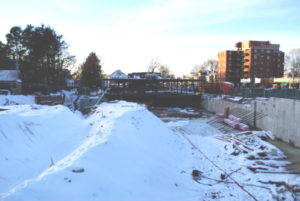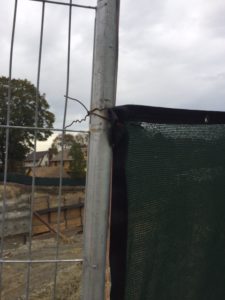But Progress is Slow and Info Is Lacking
by John DiCocco
Would you buy a used car from Toll Brothers?
Trust is difficult when repeated questions go unanswered. Since our last story in September 2017, “What’s The Latest in Cushing Square?”, construction has been slow and information flow has been slower. It’s wise for the town to continually kick the tires and keep having its own mechanic inspect the goods.

Looking at the Bradford construction site from Common Street, the mound in the center is where the contaminated soil is piled. (John DiCocco photo.)
Fencing, one lingering safety issue has finally been addressed, while another, contaminated soil, took a new turn. The project was shut down December 11 because of a permit problem. Ongoing redesign of building interiors still leaves doubt as to whether “dens” and “offices” are just euphemisms for third bedrooms, which are not permitted in the project. The town is still waiting for details on the change in exterior building materials Toll has proposed.
Clearly, the large hole in Cushing Square, accompanied by traffic congestion, decreased parking, pedestrian detours, and noise, will be there for months to come.
Fencing, one lingering safety issue, has finally been addressed, while another, contaminated soil, took a new turn.
One Accident Makes the Case
Highlighting one of the concerns the Cushing Square Neighborhood Association (CSNA) has been raising for months, there was an auto accident on November 3 at the intersection of Common and Belmont Streets. The accident left one car only about eight feet from the construction pit edge. The driver of that vehicle was not at fault (he was hit by another vehicle that ran a red light while turning), and was visibly upset when he saw the 30-foot drop-off and how close his car was when it finally came to a stop.
For months, there was a thin chain-link fence as the only barrier between the street and the construction pit, particularly on the Common Street side. The steep drop was mere inches from the roadway in some sections.
By mid-December, Nauset Construction, the general contractor, installed jersey barriers on Common Street following residents’ push for them since earlier in the summer. It was not the total solution CSNA was expecting, but it still greatly reduces the risk of a vehicular accident sending a car into the pit. According to CSNA, however, the barriers should be linked together with steel rods, and anchored into the roadbed (if they aren’t yet), in order to provide a stronger and more effective barrier.
Cushing Square merchants will be evaluating whether the barrier renders the parking spots problematic to use or if the installation is workable.

One example of flimsy, unsafe fencing at the Bradford: a piece of canvas held by a single strand of poorly wrapped wire. (CSNA photo.)
Permit Lacking
On December 11, the Office of Community Development (OCD) shut down construction on the site after being notified that Toll had put up new steel framing. Toll and Nauset had not submitted a construction mitigation plan to the town, and therefore a building permit had not been issued. Within a couple of days, Toll got the permit and resumed work.
Contaminated Soil Remains
In October, the toxic soil treatment was still going more slowly than planned. Remediation began in late spring and was projected by Toll to be completed in about six weeks. As we go to press in January, at least some of the contaminated soil is still there, in the section once occupied by Tops Cleaners. It was necessary to neutralize it onsite before it could be dug up (and thus exposed to the air) and carried away. From the report of John Thompson, the town-hired licensed site professional: “. . . Following an October meeting on egress routes, there was a reasonable chance that some of the soil would be exiting the site still classified as hazardous waste.” According to Doug Koplow of CSNA, “Site neighbors have noted multiple occasions thus far where vehicles haven’t been properly washed or dirt spilled onto roadways for other reasons. Ensuring proper procedures are followed when the soil is hazardous will be critical.”
In December, a large mound appeared in the middle of the site. Thanks to the work of resident Kathy Rushe, CSNA learned that:
• the mound was built by consolidating the hazardous soil into a smaller, though higher, footprint
• Toll was purposefully leaving the soil exposed to the air during the day to supposedly dry it out
• the consolidation of the soil was not discussed with the MA Department of Environmental Protection (DEP) ahead of time
• when the DEP inspected the site, they were not at all pleased with the approach. They required the pile to be brought down to below the fence line and properly covered at all times, in order to reduce the risk of the wind spreading the contaminated soil.
According to Toll’s project manager, Otto Weiss, the contaminated soil will go out in the same trucks as the regular soil, but the trucks will have a liner and a better cover to ensure no leakage. The trucks and tires will be decontaminated per DEP regulations, and the soil will be shipped to a disposal facility in Indiana. They will use police details through this process, which is expected to take about four weeks.
Town Oversight
The Planning Board (PB) has been in transition with the replacement of three of its members in recent months. Chuck Clark, the new chair, says the board’s liaison to the project right now is Jeffrey Wheeler, in OCD.
In late December, Wheeler and Glenn Clancy, OCD director, met with the developer and the contractor to get a status update on the project. Clancy asked the contractor for a weekly forecast of the anticipated work. The contractor agreed to do so.
Wheeler also reviewed with the developer the documents (required in the original Special Permit for the overall project)prior to the issuance of a building permit. He indicated that he should expect those documents in the next several weeks with the hope that the Planning Board could sign off on them by the end of January.
Finally, the study/den/office issue has not yet been resolved. The architect e-mailed revisions that need to be reviewed. Wheeler expected to have this issue resolved within the next several weeks. Since there are four new members on the Planning Board who need to be quickly brought up to speed on the Bradford, he expects to spend a fair amount of time reviewing the project.
Meanwhile, the town extended the contract for John Thompson so he can oversee the final steps of remediation. Koplow of CSNA stated, “John’s involvement has been extremely helpful thus far, and we are grateful to Glenn Clancy and the Board of Selectmen for authorizing this.”
CSNA has highlighted the following five areas where they or the town have requested information, and Toll has not been forthcoming.
1. Construction timeline and permits. The schedule seems to be slipping, and there should be regular updates to understand how slippage will affect neighbors and whether the town will again be asked to extend the construction schedule with no financial penalties. Also, important permits have not been issued.
2. Noise. We want to ensure that noise requirements on the project preclude a repeat of the problems that arose at the Wellington. A set of questions was submitted to the acoustic engineer the town hired to review the noise data submitted by Toll nearly a year ago, but there has been no response.
3. Shadows. As Toll continued to redesign the shape of the upper floors, the discussion of the changes at the public meetings never addressed how they might impact abutters. Some of the immediate neighbors requested more information on this about four months ago; and CSNA requested updated shadow studies to ensure there are no pending problems two or three months ago. We have gotten no response.
4. Materials quality. A key focus of CSNA and the PB members at the time the original special permit was issued was that high-quality materials be mandated in the project, rather than “value-engineered” solutions that would not wear well. This was the focus of some debate by the PB once Toll started to substitute materials, though some of the materials were never discussed before the PB approved the new plans. The PB felt that since they had the ability to review actual mockups later, they could better evaluate quality at that time. We need visibility on this process to ensure that the structure’s quality and aesthetic isn’t sacrificed to save a few dollars now.
The Planning Board was in the process of critically evaluating floor plans, though the main person doing this was among the three who resigned. CSNA needs more visibility on this process as well.
5. Room counts. Toll had redesigned apartments to include a slew of “offices” and “dens.” Many of these are easily convertible into extra bedrooms, creating fiscal risks of having many more school-age children entering the schools from the development than had been planned for. The PB was in the process of critically evaluating floor plans, though the main person doing this was among the three who resigned. CSNA needs more visibility on this process as well. [Toll is using a similar “dens and offices” strategy on a new project in Cambridge.]
Two other items remain. One is a detailed description of the town’s plan for when and how they will review construction mockups so they can better evaluate the quality of materials substitutions that Toll has made in order to simplify construction and save the firm money. The other is a summary of the completion and availability of the construction mitigation plan.
The reconstituted planning board needs to watch the project closely. With the steady vigilance of CSNA and town officials like Clancy and Wheeler, perhaps the town will eventually have something close to the project they envisioned when this process began back in 2010. Meanwhile, keep checking the oil.
John DiCocco is editor of the Belmont Citizens Forum Newsletter.


Sorry, the comment form is closed at this time.